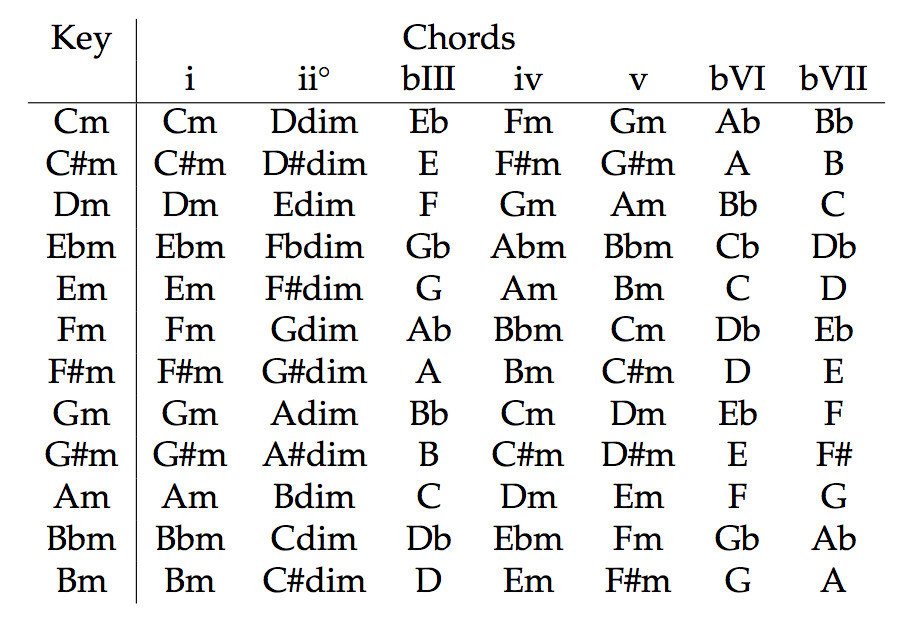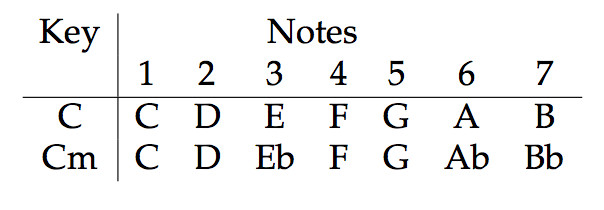Understanding minor keys is crucial for guitarists looking to add depth and emotion to their music. Just like major keys, minor keys are built upon scales, and these scales dictate the chords available to you. This guide will break down the chords of the minor scale, offering a clear path to composing and improvising in minor keys.
Understanding Chord Structure in Minor Scales
If you’re already familiar with major scale chords, you’ll find similarities in minor scales, but with key differences that create that characteristic “minor” sound. Every minor scale, like its major counterpart, contains seven chords. These chords consist of three major chords, three minor chords, and one diminished chord. What sets minor keys apart is the order in which these chord types appear.
It’s essential to remember these fundamental principles:
-
Scale-Chord Connection: Chords within a minor key are derived directly from the notes of the minor scale. For instance, the A minor scale includes the notes A, B, C, D, E, F, and G. Consequently, the chords associated with the A minor scale are Am, Bdim, C, Dm, Em, F, and G. Each note of the scale corresponds to a specific chord.
-
Consistent Chord Order: The sequence of major, minor, and diminished chords is consistent across all minor keys. The first degree of any minor scale will always be a minor chord, the second degree a diminished chord, and so on. This predictability makes learning minor key chords systematic and applicable to any key.
To illustrate these concepts clearly, refer to the table below, which outlines the chords for every minor key:
 Minor Key Chord Chart
Minor Key Chord Chart
You might notice ‘♭’ (flat) symbols preceding some chord numerals (♭III, ♭VI, and ♭VII). This notation stems from music theory’s foundation in the major scale system. Let’s clarify this with a comparison of C major and C minor scales:
 C Major vs C Minor Scales
C Major vs C Minor Scales
As shown, the 3rd, 6th, and 7th notes of the C minor scale are flattened compared to the C major scale. The ‘♭’ symbol in chord notation reflects this flattening, indicating that the root note of these chords is a half step lower than expected in a major scale context. For example, III would typically denote an E major chord in a major scale, so ♭III specifies an Eb major chord in the minor scale context.
Crafting Chord Progressions in Minor Keys
When composing in minor keys, a common practice is to start and end chord progressions on the tonic chord (the first chord of the key). This tonic chord provides a sense of resolution and finality in minor key compositions.
Apart from the diminished chord (which we’ll address in more advanced discussions due to its specific usage), the chords within a minor key generally sound harmonious when played in sequence, regardless of order. This characteristic opens up creative possibilities for songwriters.
Similar to major scales, you can experiment with random chord selection within a minor key to inspire song ideas. Here’s a simple method:
-
Dice Roll Composition: Roll a dice three times and note the results. For example, let’s say you roll 6, 2, and 4.
-
Start with the Tonic: Begin your progression with the first chord of your chosen minor key. If we’re in C minor, start with Cm.
-
Chord Selection based on Dice: For each dice number, add 1 to it. This adjusted number corresponds to the chord degree in the minor key. For our first roll of 6, adding 1 gives 7, indicating the 7th chord (♭VII). In C minor, the ♭VII chord is Bb.
-
Continue for Remaining Rolls: Repeat step 3 for the other dice numbers. With rolls of 2 and 4, we get 3 (♭III) and 5 (v) respectively. In C minor, these chords are Eb and Gm.
Following this process, our example dice rolls (6, 2, 4) in C minor yield the chord progression: Cm – Bb – Eb – Gm.
While this C minor progression is theoretically sound, it involves barre chords which can be challenging for some guitarists. To simplify playability, we can transpose the same numerical progression (i – ♭VII – ♭III – v) to a different minor key. Applying this to A minor results in Am – G – C – Em. This A minor progression is significantly easier to play, utilizing common open chords.
A fundamental principle in music theory is that chord progressions retain their sonic character when transposed to different keys, as long as the numerical relationships between the chords (chord degrees) remain consistent. Changing keys simply shifts the overall pitch range, making the progression higher or lower, but the emotional feel is preserved.
To delve deeper into minor key composition and explore related modes that offer similar yet distinct sonic flavors, consider exploring resources dedicated to guitar modes. These resources can significantly expand your understanding of minor key harmony and unlock further creative possibilities.
[
